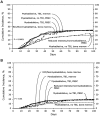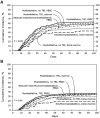Risk factors for acute GVHD and survival after hematopoietic cell transplantation
- PMID: 22010102
- PMCID: PMC3251233
- DOI: 10.1182/blood-2011-06-364265
Risk factors for acute GVHD and survival after hematopoietic cell transplantation
Abstract
Risk factors for acute GVHD (AGVHD), overall survival, and transplant-related mortality were evaluated in adults receiving allogeneic hematopoietic cell transplants (1999-2005) from HLA-identical sibling donors (SDs; n = 3191) or unrelated donors (URDs; n = 2370) and reported to the Center for International Blood and Marrow Transplant Research, Minneapolis, MN. To understand the impact of transplant regimen on AGVHD risk, 6 treatment categories were evaluated: (1) myeloablative conditioning (MA) with total body irradiation (TBI) + PBSCs, (2) MA + TBI + BM, (3) MA + nonTBI + PBSCs, (4) MA + nonTBI + BM, (5) reduced intensity conditioning (RIC) + PBSCs, and (6) RIC + BM. The cumulative incidences of grades B-D AGVHD were 39% (95% confidence interval [CI], 37%-41%) in the SD cohort and 59% (95% CI, 57%-61%) in the URD cohort. Patients receiving SD transplants with MA + nonTBI + BM and RIC + PBSCs had significantly lower risks of grades B-D AGVHD than patients in other treatment categories. Those receiving URD transplants with MA + TBI + BM, MA + nonTBI + BM, RIC + BM, or RIC + PBSCs had lower risks of grades B-D AGVHD than those in other treatment categories. The 5-year probabilities of survival were 46% (95% CI, 44%-49%) with SD transplants and 33% (95% CI, 31%-35%) with URD transplants. Conditioning intensity, TBI and graft source have a combined effect on risk of AGVHD that must be considered in deciding on a treatment strategy for individual patients.
Figures


Comment in
-
The Serenity Prayer for acute GVHD.Blood. 2012 Jan 5;119(1):3-4. doi: 10.1182/blood-2011-11-388215. Blood. 2012. PMID: 22223818 No abstract available.
References
-
- Anasetti C, Beatty PG, Storb R, et al. Effect of HLA incompatibility on graft-versus-host disease, relapse, and survival after marrow transplantation for patients with leukemia or lymphoma. Hum Immunol. 1990;29(2):79–91. - PubMed
-
- Champlin RE, Schmitz N, Horowitz MM, et al. Blood stem cells compared with bone marrow as a source of hematopoietic cells for allogeneic transplantation. IBMTR Histocompatibility and Stem Cell Sources Working Committee and the European Group for Blood and Marrow Transplantation (EBMT). Blood. 2000;95(12):3702–3709. - PubMed
-
- Eisner MD, August CS. Impact of donor and recipient characteristics on the development of acute and chronic graft-versus-host disease following pediatric bone marrow transplantation. Bone Marrow Transplant. 1995;15(5):663–668. - PubMed
-
- Gale RP, Bortin MM, van Bekkum DW, et al. Risk factors for acute graft-versus-host disease. Br J Haematol. 1987;67(4):397–406. - PubMed
-
- Hägglund H, Bostrom L, Remberger M, Ljungman P, Nilsson B, Ringden O. Risk factors for acute graft-versus-host disease in 291 consecutive HLA-identical bone marrow transplant recipients. Bone Marrow Transplant. 1995;16(6):747–753. - PubMed
Publication types
MeSH terms
Grants and funding
LinkOut - more resources
Full Text Sources
Other Literature Sources
Medical
Research Materials

